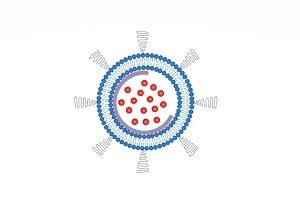For many years, researchers have analyzed the use of liposomes, which are hollow spheres composed of lipid bilayers, to transmit chemotherapy drugs to tumor cells.

In this illustration, a nanobowl (purple semicircle) supports the structure of a liposome (blue membrane bilayer) to help keep a chemotherapy drug (red) from leaking out. Image Credit: Nano Letters 2020.
At times, drugs can leak out of liposomes before they reach their targeted site, lowering the dose acquired by the tumor and leading to side effects in healthy tissues.
In a study published recently in Nano Letters journal from ACS, scientists have reported a method to stabilize liposomes by integrating a rigid nanobowl in their internal cavity.
The researchers have experimented with many different techniques to prevent the liposomes from leaking out, like crosslinking lipids in their bilayers or coating their surfaces with polymers. But these changes can modify the characteristics of liposomes, allowing them to communicate differently with cells.
Chao Fang, Jonathan Lovell, and collaborators wanted to identify a new method to stabilize liposomes that keep their surfaces intact. The researchers decided to try nanobowls, which are concave nanostructures with an opening that permits the drugs to escape as soon as the liposomal bilayers disintegrate within a cancer cell.
The researchers reasoned that if the lipid bilayer is assembled around the nanobowl, the liposome would be mechanically supported by the rigid structure.
As such, the researchers prepared silica nanobowls, altering their surfaces with a positively charged chemical group and also assembling a negatively charged lipid bilayer around every structure. The chemotherapy drug doxorubicin was then loaded into the water-filled center.
The resulting liposomes, stabilized by the nanobowl, were less leaky when compared to the normal liposomes present in serum or under sheer stress, as would be seen in blood vessels, but still discharged doxorubicin when used up by cancer cells in a dish.
In an experiment conducted with mice with transplanted metastatic breast tumors, it was found that animals administered with the nanobowl-liposomes had a longer lifespan when compared to the ones receiving regular liposomes.
In addition, mice treated with nanobowl had smaller tumors when compared to the group receiving standard liposomes and cancer had not infiltrated to their lungs in comparison to the other group.
The researchers stated that this simple yet effective technique should be “easy for wide application and holds the potential for clinical translation.”
Source:
Journal reference:
Chen, Z-J., et al. (2020) Nanobowl-Supported Liposomes Improve Drug Loading and Delivery. Nano Letters. doi.org/10.1021/acs.nanolett.0c00495.